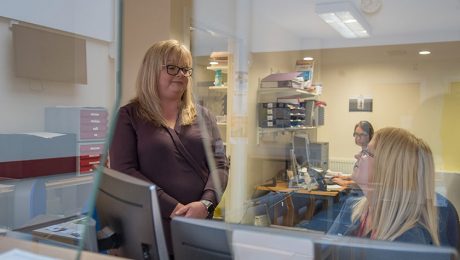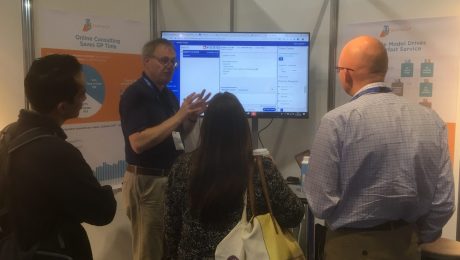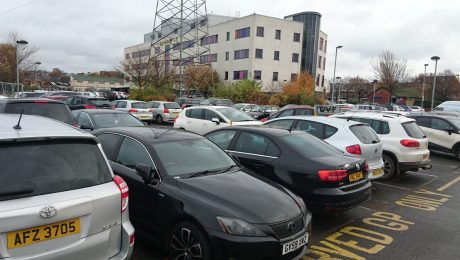The Flaw of Averages
The “Flaw of Averages” was I understand first observed when a trainee statistician drowned while fording a river which he calculated had an average depth of 2 feet.
You can tell he was American. A British trainee would have made the average depth 0.945m.
We are seeing 7,000 online consultations per week through askmyGP, from about 250,000 patients covered. At 2.8% of total list, that would be about a third of total demand on average, right?
You know I’m going to say “wrong” and the flaw explains very simply why.
It turns out the practices divide into three cohorts, which I’ll call the swimmers, runners and rollers.
The swimmers see under 5% of demand online. There may be a lot of splashing, but speed over the ground is quite low, benefits are hard to measure and an adverse current may even sweep them away. An askmyGP icon decorates their website, leaflets and posters are all over reception but for any patient using it, service is slow and frankly, the telephone seems a safer bet.
Runners are in the range 20 – 40% online, it’s a main mode of access with good service and generally high patient satisfaction. Benefits for the practice are significant and they can handle all patient demand on the day. But they are still running two systems, with mixed messages to patients. While they know online is more efficient, they may still limit access, so patients revert to telephone.
Rollers are putting 100% of demand through askmyGP, between 50 and 80% online from patients, the rest by telephone into reception. In this total flow mode, GP digital triage means they manage all their workflow with an efficiency simply impossible by any other means.
What does this mean for us?
We want to increase usage because, while we incur some volume related costs, it’s much more valuable to us when customers and patients get the most benefit from askmyGP, and that is after all our vision.
But while it might be tempting to persuade, cajole or incentivise practices to push up their average % usage by a few points, it would be a waste of everyone’s time.
Quite simply, we need to get them all rolling along in total flow mode. They’ll experience the benefits all for themselves with no pushing and shoving from us.
Here’s the thing: all our customers have exactly the same software, and the same advice. They are just making different choices, and seeing radically different outcomes as a result.
The great news is that all our new launches are rolling from day one. It works best that way.
Any triathletes will have spotted the analogy but there’s an added twist: transition between the modes seems to be remarkably difficult. People settle into a mode of operation and to shift seems just, well, a bit of an effort.
It’s not impossible, with Witley & Milford shifting three weeks ago and immediately doubling their speed of flow. After one week, someone briefly went back to the old system and was very quickly corrected!
So while new practices are all getting the max, how do we move the others?
Scratches head.
Harry Longman
PS What about the spectators? Very simply and with no commitment, you can be the GP managing the incoming total demand. It’s real, randomised and anonymised patient data, and when you have your login it will take about 15 minutes to rattle through 50.
Register for our free Digital Triage Experience.
- Published in Comment
askmyGP launches video consulting
We’re delighted to have reached a milestone today, just over four months after launching version 3. Steve Black our chief analyst told us:
“At 08:31 this morning Aisha at Balaam Street closed the 100,000th patient episode.”
Wonderful to know that in the absence of a functioning government, some things keep rolling along.
History is informative but I’m even more excited about the present, as we announce today the launch of video consulting through our askmyGP platform.
- No app to download
- No need to change surgeries
- Works on any device with a camera
- Your own NHS GP initiates the call
The first ones have happened already, one GP telling me of a child he could see happily running around- saving a visit, and a mole he could tell was benign – giving reassurance. Another tells me of checking on a wound and saving a whole morning off work for a patient.
The experience was easy for both parties, with high quality pictures over wi-fi, and no cumbersome pre-booking arrangements.
Video consults are driven by what is clinically appropriate in the GP’s view, and it’s going to be so interesting to see how this mode affects practice. My guess is it will be around 5 – 10% of consults, but this is the thing: we don’t know.
Have a lovely evening.
Regards
Harry Longman
![]()
- Published in News
Good news from GP patients
Good news has a hard time getting heard.
This week we’ve seen new, comprehensive data from NHS Digital on the wait to see a GP, splashed across all the papers:
Guardian: “One in five patients waits two weeks to see a GP”
Times: “Millions face a three week wait”
Telegraph: “One in ten waits three weeks to see their GP”
It’s all “true”, though I’m afraid the spin is not. The argument that “40% are seen the same day” rings hollow with anyone who has hung on the telephone for half an hour, to be told that all the same day slots have gone. Many of those 40% have been trying for several days just to get through.
Blame the patients, blame the government, blame whoever else we can think of. Or take a different look.
These tiny stories from the last few days are just a handful of the hundreds we see each week from patients grateful to their GP:
Your service and reliability are amazing. Thank you! (f 85)
Amazing fast system thank you (m 41)
Amazingly swift and very easy process than trying to jugggle around work – thank you so much! (f 24)
Amazing…More personal…Super speedy (parent, boy, 3)
Love how easy it is to speak to your own doctor . Amazing (parent, girl, 4)
Love this new system…so easy and quick , and have the problem solved without having to sit around at the surgery. (f 49)
Love ‘askmygp’. Making it so much easier to get info and solve problems whilst holding down a full time job! (f 40)
Wow. I am impressed! (m 69)
Wow, just wow. Have been in terrible painall night…absolute godsend… Thank you so much for your skills and innovations (f 65)
WOW, great system, quick easy, and no need to travel. Many thanks (m 63)
We’re now over 4,600 feedbacks from 80,000 episodes since August, and the trend is better and better. Please do have a look at the live rolling 7 day summary chart. We ask patients whether it’s better or worse and the ratio as I write has moved up to 9 which is so exciting.
These patients are getting an outstanding service from their own regular NHS GPs. The GPs have no extra funding (they pay us), and no complicated extended hours 8 to 8 hubs (that didn’t work)
Patients didn’t have to switch to an out of area GP. They could name their own GP. They were seen same day if needed.
And the GPs are happier too – happier professionally to be giving such a service and bringing the joy back into their working lives.
If you haven’t yet watched the Burnbrae video, please do and click for the demo at the end. This is one of her 5,000 patients last week, helped within 2 hours:
“fantastic service and Dr Arnott is an amazing doctor, Shotts is lucky to have all these new changes.”
How do we get this into the headlines?
Regards
Harry Longman
- Published in Evidence
Games Patients Play
Looking up Eric Berne’s classic “Games People Play” I was surprised to find it was published in 1964. He calls it “a way of predicting people’s behaviour.”
It would be pleasing to say we have learned more as time has passed. I doubt it would be true.
Without going into the great psychiatrist’s theories too far he was clear that destructive games caused a lot of pain not only to his patients but to all of us in our daily lives.
I was reminded of these ideas when joining in a Twitter conversation about DNAs (did not attends), a GP complaining that 4 out of 7 patients hadn’t turned up – blame the patients for wasting GP time, NHS resources and slots which someone in need could have taken.
It all makes sense, until you realise that these were Saturday morning “extended access hub” slots. We know that very few patients want weekend slots, and they don’t like to travel away from their own surgery or see someone they don’t know. They were sent there and then as their own practice gave them that option or nothing.
We know that the longer the gap between the booking and the date of the appointment, the higher the DNA rate. On the same day, DNAs all but vanish. Our practices don’t talk about them any more. If changing the system with the same patients eliminates the problem overnight, it follows that DNAs are a system problem, not a patient problem.
The blame game is very simple: “We tell you when and where you will be seen, by whom. We blame you for not turning up.”
We find the same things happening with all kinds of variation. The most common game for appointments is “Nothing left today, you’d better call tomorrow but make it early as they all go around 8 am”. A friend of mine had the whole family of six call the surgery at 8am to increase the chance of one of them getting through.
Another game is “We’re very busy so we allow booking up to six weeks in advance for routine matters”. The mother would take the slot, and would turn up herself or with whichever child or frail elderly relative was most in need on the day.
A new one on me recently was “If you phone in the morning a nurse will triage you. Phone after 12.30 and a GP will triage you for the next day”. In seven years this is the first ever practice I’ve met which has more “demand” in the afternoon.
Whenever we start work with a practice we ask them how the appointment system operates, and we look at their website. So often they summarise it in the two words, “It’s complicated.”
We’ve reached the point that we know from the rules what games patients will play. Then we get the data on demand patterns and it turns out exactly so.
It’s really “Games providers play”, and the cost they and their patients pay is rework. Everyone gets locked into the game, working like stink, deeply frustrated, achieving little.
I love what Eric Berne says in his field:
“Everybody has a hunger for intimacy, a game free zone where people are straight with each other.”
The alternative for practices is to rewrite the rules very simply:
“Let us know your problem, whenever you like. Tell us who you would like to help you, if not anyone, how you’d like us to contact you, and any issues with timing.
“We’ll work out very fast how to help you. No promises, but we’ll do our best to meet your preferences too.”
What happens is quite astonishing. Not only do patients almost always find their needs met, but because there’s so little rework, it’s less effort for providers.
This week from a Bristol patient: “So much easier as I have time to think what I want to say, and it frees up staff to do what they need to do.” We get dozens every week on the same theme.
Games over.
Harry Longman
- Published in Comment
Failure. It’s bound to happen.
Innovation is risky, and change is risky, so it should come as no surprise that we have failures. Perhaps we have more to learn from failure than success, which means we must reflect.
Since launching askmyGP v3 in August we’ve had three practices turn it off. I won’t name them, suffice to say they differ widely in size, demographic and location, but you all want to know why they gave up.
The common theme in what they told us was that they felt unable to cope with patient demand.
Yet patient demand was very close to predicted, within 10%, as it has been with the great majority of successful practices.
We do point out that unmet need is uncovered when limits are removed, which may appear to be a rise in demand in the early weeks. A small number of patients will abuse the new system, as they did the old one, but we’ve found from our Datalog audit that in the GPs’ view this is around 3% both before and after launch.
We don’t say it will be easy. We do say that with perseverance both patient service and GP working lives improve. But those that start from a strong patient service ethos seem to do best for their own working lives too.
The commitment to fast and appropriate response from the whole team puts them in control and minimises rework. That doesn’t mean saying yes to what every patient “wants” – that way lies madness. It does mean sufficient breaks around GP and staff needs. Indeed the day can be much more flexible, with many opting to work from home part of the time.
While failure means a return to the previous state with all its frustrations and stresses, success is a journey not an endpoint. It’s all about flow, measured continuously:
- Patient demand, by type, mode and timing over weeks, days and hours. This matters for designing the service.
- Elapsed time to complete requests. Usually the chief concern of patients.
- Continuity, where appropriate. Often key to patient satisfaction, GP job satisfaction and quality of care.
- Efficiency, a chief concern of providers as it drives workload, quality of working life and profit.
- Patient satisfaction, for which we publish summary charts in real time:
The benefits from wholly embracing system change are orders of magnitude greater than from any hybrid system, and a large part of our work is giving practices the confidence to do so. Followng that is an enchanting journey of learning, experimentation and refinement.
We too are continually learning, often finding we can help the flow with new features, better measures, or working with practices to solve unique problems. Sometimes we change our advice,
While change cannot be absolutely risk free, for many businesses, staying the same may be the most risky strategy. We only have to walk down our high streets to see the consequences. For most GPs, protected as they are by permanent contracts, staying the same and offering a service no worse than others locally may not seem too bad, though it hardly inspires.
Our greatest challenge, and by far the greatest cause of failure, is failure to overcome fear, to reach consensus and therefore failure even to start. Let’s re-iterate our purpose in undertaking this work:
We make it easier for patients to get help from their own GP.
We make it easier for GPs to provide that help to their own patients.
Sometimes the way may seem hard, but reward comes through perseverance. We have a mantra to take us through those times:
“First for our patients, then for ourselves.”
Harry Longman
PS After the rain, sunshine. I’m about to share some of the most moving patient feedback we’ve had, just from the past week.
- Published in Comment
How to run a more profitable practice
Last month we were at Best Practice conference in Birmingham and having a jolly good time until something really annoying happened.
We’d spent a lot of effort on our stand and if you’ve ever done these events you’ll know the few square metres cost £ thousands, never mind the little table and bar stools which are more to rent for the two days than they would be to buy.
We were dead opposite a mini theatre where every hour someone would roll up, no doubt having paid more £ thousands, to do their presentation on the latest dermatological cream or ear inspection widget. They’d pull in a couple of dozen delegates, grateful for the chance to sit down and fiddle with their devices.
Then all of a sudden we find custom has dried up and we are looking at the backs of a huge audience, filling all the chairs and spilling into the space around our stand. Everyone rapt.
The title: “How to Run a More Profitable Practice”
Sorry I have no idea what he was on about, I couldn’t see over the crowd, but he was one of the small army of advisors which serve general practice.
They are the accountants, solicitors, lenders, financial advisers and so on who make their crust knowing the many little levers of profit which independent contractors can play on to their hearts’ content. Good luck to them.
What amuses me is that when we ask GPs what are their priorities in undertaking change, 93% of them put “money” as the lowest (out of 5) of their concerns. Haha.
What amazes me is that these same GPs getting advice on how to reclaim VAT on rubber gloves are not even thinking about the dominant cost in their businesses, which is of course the GPs – their own time, their salarieds and especially their locums’ time.
The main cost of meeting patient demand is GP time. (by the way, this is why “GP at Scale” is doomed to have precious little effect on drawings. It’s no more efficient for consultations, and possibly worse because of lost continuity)
Therefore the best way to be more profitable is for the GPs to be more efficient. (I’m not including the option to turn patients away. No matter how much it happens, it’s plain wrong).
Bluntly, with askmyGP we enable GPs to be far more efficient in dealing with patient demand. How much, how fast, how that is balanced between fewer sessions, finishing earlier, running more patients or giving a better service, all those factors vary.
Just to get a sense of how that works out, watch our new three minute video, the Burnbrae story. Dr Sue Arnott is so cool and calm, as a full time single hander with her team running 5,000 patients.
You do the maths.
Harry Longman
PS we’ve had a tremendous response from GPs signing up to the Digital Triage Experience even before we put it on the website, but click the link and we’ll create yours. You will make your own triage decisions on 50 cases within about 15 minutes, and see why this is the greatest lever on profit you’ll ever find.
- Published in Comment
A climate of change
I’m sitting here in my shorts, tee shirt and sandals and it’s the middle of October. Yes, I’m in Leicestershire, for those thinking laterally, and I have a jumper on, but I felt it worth dressing up to make the point.
Unless you’ve already settled on Mars, you’ve noticed that it’s significantly warmer than in your youth and while a fine warm week in October is weather rather than climate, we know the trend is one way.
The IPCC warned this week that our fossil fuel burn must fall more rapidly than we thought. Policy must change, and behaviour must change.
We link our work with askmyGP directly to lower carbon use, because it saves travel to the GP surgery. It’s hard to measure the numbers with telephone consulting, but we have much better data now with some 10,000 patient requests via askmyGP each week. Roughly 9,000 are for the GP, of which 6,000 are resolved remotely. Say half would have involved a car journey of say 1 mile each way, that’s 6,000 road miles saved – and we have only just started.
I’m optimistic that if we do the right thing, a lower carbon future can be a better one all round, and I’m glad to say the patients agree.
“Fantastic service, much easier to speak to GP whilst sitting in the comfort of your own home. Many thanks” f 53
“So much better than getting in the car and visiting. Personal chat with my GP at a time convenient to us both.” f 65
“I think the new system is excellent. Saves time and must give the doctor more time to see patients who actually need proper medical attention. Saves me from having to bundle my 1 year old son on a bus and come up for nothing. Love the new system!”
And why should patients have all the fun? One of our practices has instituted a work-from-home-day for all the partners. They are as productive as ever if not more so, one telling me she saves a 50 minute car commute each way.
GPs keep telling me they are terribly stressed, and I’m sorry we don’t do counselling or mindfulness sessions. All we can offer is to change the system, but consulting in slippers is quite nice.
Anyway, if you haven’t yet seen it, listen mindfully for 25 minutes as
Warm wishes,
Harry Longman
PS. When each request is completed, we invite the patient to leave feedback and about 5% do so. The real time chart shows about 3 to 1 say the new system is better v worse, but one wrote this yesterday which was moving:
“It’s more than better. This is revolutionary. No waiting to see a GP and the speed at which the service delivered is outstanding.
I’ve switched practices to Central….the doctors are way above my previous experiences with another practice” m 67.
Another patient yesterday wrote the longest comment we’ve ever seen, an essay. I’m going to publish it tomorrow, do look out.
*Featured image is one I took in a GP car park, the environmental consequence of “GP at scale”.
- Published in Comment











Fly me to the moon
What a year it has been already. First NASA’s New Horizons discovers a snowman at the edge of the solar system, then Chang’e 4 lands in a crater on the far side of the moon.
What are your dreams for 2019?
I learned this week from the little museum in Grantham that Margaret Thatcher’s father inspired her with the idea that “if you can think it, you can do it” (Love her or loathe her, there’s no question that she changed Britain. Yes, it was a small grocer’s shop, away from the town centre and no indoor bathroom).
So our dream for 2019 is that as we bring about happier patients and happier GPs, we help the profession to be more of what it is meant to be.
What is general practice meant to be?
My discovery of the week was the RCGP James Mackenzie Lecture given on 20th December by Prof Chris Salisbury. What better title than “Designing healthcare for the people who need it.”?
Christmas and New Year are past, we’re getting the house straight again, and have more time to reflect. So I have a little work for you today:
Listen in full to Prof Salisbury’s lecture on Youtube.
In under 50 minutes you will need to think, you will be challenged, you will laugh, and yet you will know it makes sense. You will contrast the conceptual strength of GP with the failures of implementation.
You will hear the most comprehensive and cogent critique of recent policy I’ve come across. If you are an optimist, you will nonetheless come away with hope that while change is necessary, if we can think it, we can do it..
We’ve had an exciting start to the year with a practice launch on 2nd January in Lincolnshire (clue!), two more next week in Somerset and an accelerating programme through the winter.
I don’t know where we’ll be at the end of the year but I know it will be absolutely focussed on implementation. Thank you Chris for helping us understand what it’s for.
If you’ve heard it once, listen again.
Download the full transcript with pictures.
Have a bolder and happier New Year,
Harry Longman
PS I’m ambivalent about Thatcher but she was right about a lot of things. A banner in the museum, “I want to turn us from a nation of “Wait until it’s given to you” to one of “Do it yourself””.
People of every political stripe can sign up to that. By the way, we’re looking for GPs with that attitude.
PPS The response has been huge already for our free Digital Triage Experience, and we have now enabled the first user in each practice to invite their colleagues. Compare notes on how you triaged each of the 50 cases and the time you saved.